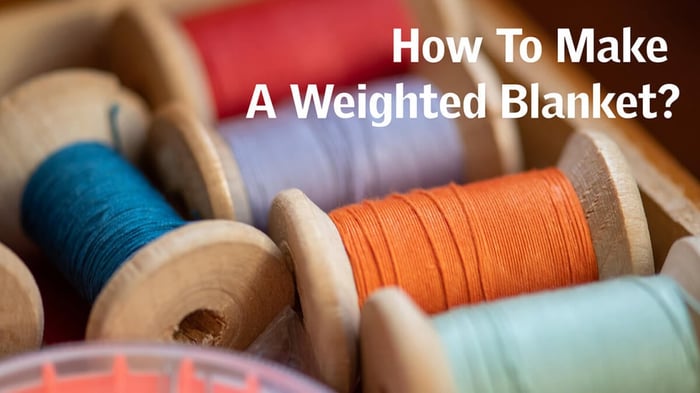Weighted blankets are becoming popular for their ability to improve sleep quality, and a variety of weighted blankets is available for purchase, in a range of prices and fabrics. While it is not difficult to find a weighted blanket for sale in stores or online, some people may prefer to try to make a weighted blanket of their own. Read on to learn how to make a weighted blanket, as well as reasons to consider doing so.
- Why make your own weighted blanket?
- What materials are used to make a weighted blanket?
- Steps to Make Own Weighted Blanket
- Weighted Blankets from Aricove
Why make your own weighted blanket?
Weighted blankets come with numerous benefits, making them rather attractive to those who desire to improve their sleep. In fact, research shows that because weighted blankets provide deep touch pressure, they calm the nervous system and can relax the body for sleep. Furthermore, studies show that weighted blankets make it easier to stay asleep and reduce fatigue among people who have conditions like ADHD, anxiety, or depression, which can all make it challenging to get a restful night of sleep. Given the benefits of weighted blankets, it makes sense to use one if you’re struggling with poor quality sleep, but the prices can deter some people from purchasing a blanket. When you’re on a budget, a makeshift weighted blanket can take the place of a premium store-bought blanket.
What materials are used to make a weighted blanket?
If you’re going to make your own weighted blanket, you will need to utilize fillers, which are the materials that add weight to the blanket. The most popular type of filler for a makeshift weighted blanket is typically plastic poly pellets, which are also found in stuffed animals. If you’re going to make your own weighted blanket, you might also consider using other common fillers, such as micro glass beads or steel shot beads, which can be found in most craft stores, along with plastic poly pellets. Some less common fillers that may be used for weighted blankets are sand, rice, beans, and pasta, but they may not be as durable, and they tend not to provide evenly distributed weight. Food products can also develop mold and attract insects. Additional necessary materials include flannel or another medium weight fabric to construct the blanket; you will need 2.5 yards for the top, and 2.5 yards for the bottom to create a blanket large enough for a twin bed.
Steps to Make Own Weighted Blanket
The following steps will help you to make a weighted blanket:
- Figure out the correct size. Once you decide how large of a blanket you will need, measure your fabric, creating equal size pieces for top and bottom. Put the top and bottom pieces of fabric together, with the right sides facing in, and measure two inches in on the long sides and one inch on the short side, leaving one side open to insert your pellets.
- Begin sewing. Sew three sides together, and then clip the bottom corners of your blanket. Next, turn the fabric right side out and flatten the seams with an iron.
- Create a grid. Using chalk or a fabric pen for marking, create a grid on the blanket, and then sew down the vertical area of the grid only.
- Weigh your filler. Determine how much filler you need, by dividing your desired weight by the number of squares in your grid. Then, weigh your filler to ensure you get the correct amount.
- Add your filler. Add the correct amount of filler to each pocket in your grid, making sure to utilize an equal amount in each pocket for even weight distribution.
- Sew the pockets. After adding the proper amount of filler, sew the bottom of each row, sewing horizontally across your grid, to close up the row. Continue until you have sewn all of your rows, and then fold over any leftover fabric and sew it closed.
- Care for your blanket. You can keep your blanket as clean as possible by placing it inside a duvet cover. Machine wash your blanket in a machine without an agitator to make it last.
Weighted Blankets from Aricove
If you are a skilled seamstress or at least comfortable with DIY projects, there can certainly be advantages to creating a makeshift weighted blanket. By using methods such as shopping at chain craft stores, or ordering supplies online from a retailer like Amazon, you can probably figure out the cheapest way to make a weighted blanket. Not only will you save money, but if you enjoy sewing, you may find that it is fun to make your own weighted blanket.
On the other hand, if sewing isn’t your thing, and you’d rather not spend the time and effort to create a makeshift weighted blanket, Aricove offers a weighted blanket for kids, as well as adult weighted blankets in 10, 15, and 20 lb versions. Our bamboo weighted blanket is made from premium fabric that is not only naturally soft, but also moisture wicking to help you maintain the optimal temperature for sleep. Our blanket design also ensures even weight distribution, providing gentle stimulation to pressure points throughout the body. For those who want to protect their investment and ensure that it lasts as long as possible, Aricove also offers a white weighted blanket cover. These benefits can make a weighted blanket worth the cost if you prefer not to make your own weighted blanket.


 United States (USD $)
United States (USD $)